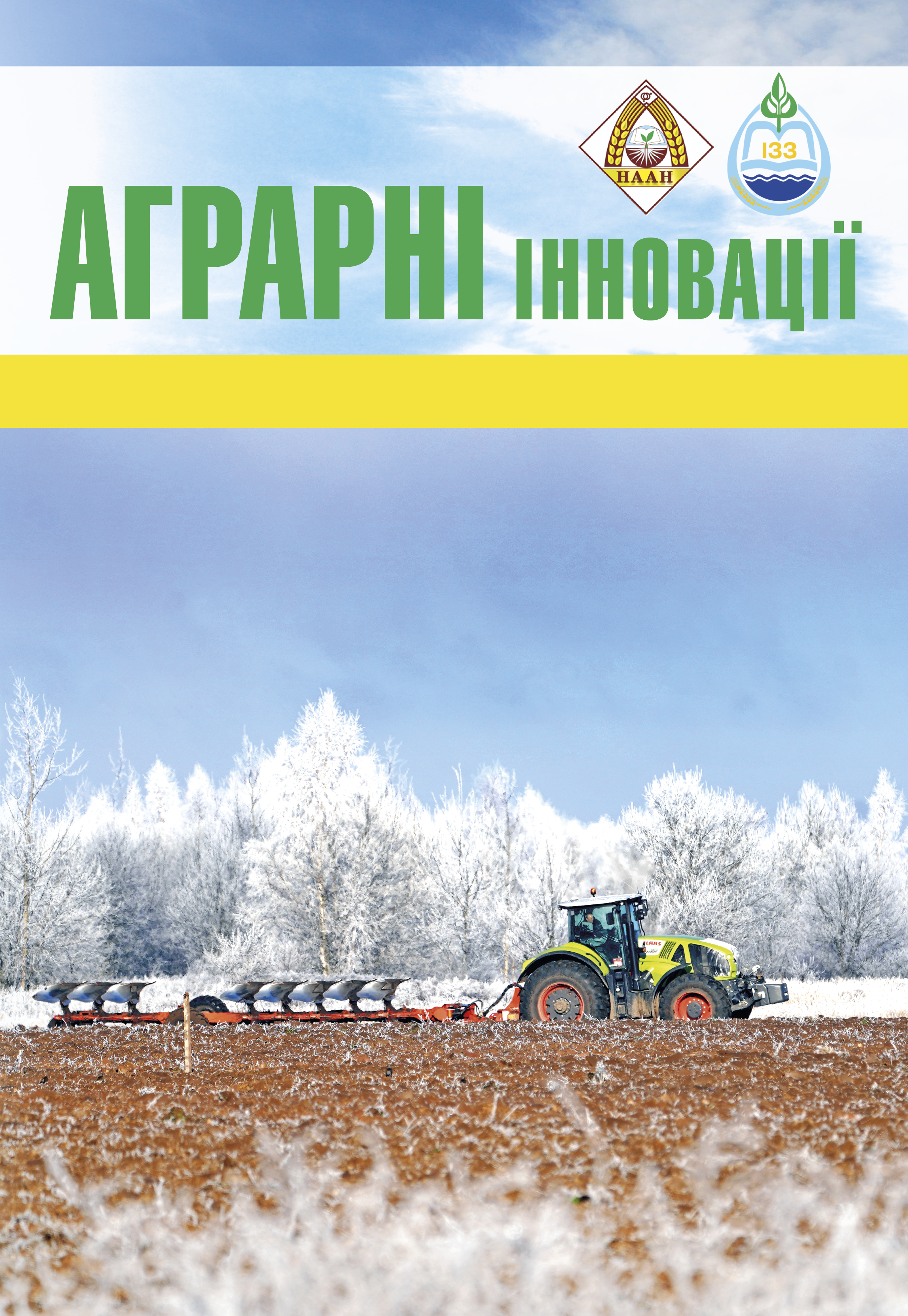The yield of the black seed (Nigella sativa L.) depending on agrotechnical and biological factors in the conditions of the Western Forest Steppe
Abstract
The purpose. The purpose of the research was to determine the influence of sowing dates, seeding rates and methods of applying plant growth regulators on the yield of the seeds of black seed when growing in the conditions of the Western Forest Steppe. Methods. In the process of carrying out the research, a combination of general scientific methods was used: hypothesis, observation, analysis; and special: laboratory and field. Experimental indicators were processed by methods of mathematical statistics. The results. The results of field and laboratory studies of influence are given: sowing dates (II decade of April, III decade of April, I decade of May), seeding rates (10, 12 and 14 kg/ha), growth regulators (Regoplant, Vermystym D, Vitazym), methods the use of preparations (seed treatment, spraying of crops) on the yield of seeds of black seed when growing in the conditions of the Western Forest Steppe. According to the results of three-year research, the feasibility of growing black seed in the conditions of the Western Forest Steppe has been established, and a set of agrotechnical measures has been optimized. The records of the seed yield of black seed showed that it varied significantly over the years of research. The most productive year was 2021 and the least productive was 2023. It was established that the sowing period and the seeding rate had a significant influence on the seed yield of black seed. The optimal yield indicators of 1.31 and 1.3 t/ha were for sowing in the second decade of April with seeding rates of 12 and 14 kg/ha, the control excess was 0.26 and 0.25 t/ha (or 24.7 and 23.8%). A significant difference between research variants was confirmed by Duncan’s test regarding the influence of the sowing period, since the values are distributed among three homogeneous groups, the average yield values were, according to the periods: 1.29; 1.08 and 0.7 t/ha. Regarding the influence of the seeding rate on the seed yield of black seed, according to the Duncan test, it was established that the indicator of the seeding rate of 10 kg/ha was in the first homogeneous group, and the values of the seeding rates of 12 and 14 kg/ha were in the second, i.e. between the last two variants, the difference was not significant. The expediency of using plant growth regulators in the cultivation of black seed has been experimentally proven. A more effective way of using drugs has been determined. It was found that the optimal productivity indicators were provided by: seed treatment with the drug Regoplant and spraying of crops with the growth regulator Vermystym D with a yield of 1.22 and 1.19 t/ha, with an excess of the controls, respectively, by: 0.26 and 0.24 t/ha, which was 27 and 25.3%.
References
2. Болгова Н.В., Маренкова Т.І. Аналіз жирнокислотного складу рослинної олії. Таврійський державний агротехнологічний університет. 2013, вип. 13. Т. 1. Мелітополь: Таврійський державний агротехнологічний університет. С. 80-86.
3. Гончарський І.Л., Линдар О.І. Вивчення продуктивності видів чорнушки залежно від агротехніки вирощування в умовах півдня України. Таврійський науковий вісник. 2018, вип. 100. Т. 1. С. 30-34.
4. Дроздова А.А., Мойсієнко В.В. Амінокислотний склад насіння сортів та видів рослин роду Nigella L. Іноваційні технології у рослинництві: проблеми та їх вирішення: матеріали ІІІ міжнар. наук.-практ. конф. присвяч. 100-річчю від дня заснув. агрономічного ф-ту, 2-3 червня 2022 р. Житомир : Поліський національний університет, 2022, с. 57–62.
5. Дроздова А,А., Мойсієнко В.В. Жирнокислотний склад насіння чорнушки (Nigella L.) залежно від видових та сортових особливостей. Таврійський науковий вісник. 2023, № 129. С. 79-86.
6. Дроздова А.А., Мойсієнко В.В. Лікарські властивості та використання чорнушки посівної в Україні. Актуальні проблеми землеробської галузі та шляхи їх вирішення: матеріали Всеукраїнської науково-практичної конференції, 09–11 грудня 2020 р., м. Миколаїв : МНАУ. 2020, с. 29-31.
7. Лікарські рослини: технологія вирощування та використання : підручник / Біленко В.Г. [та ін.] ; за ред. Б.Є. Якубенка; Національний університет біоресурсів і природокористування України. Житомир : Рута, 2015, 600 с.
8. Мирослав Семенюк. Вчені знайшли новий засіб проти COVID-19: може блокувати цитокіновий шторм // https://covid.obozrevatel.com/ukr/vcheniznajshli-novij-zasib-proti-covid-19-mozhe-blokuvatitsitokinovij-shtorm.htm.
9. Ніколова Н.С., Данилів С.І. Аналіз жирної олії nigella sativa l. виробництва України та Болгарії. Вісник медичних і біологічних досліджень. 2022, 1(11), С. 80-83.
10. Інтродукція Nigella sativa L. в умовах ботанічного розсадника Житомирського національного агроекологічного університету. Світельський М.М. та ін. Вісник Національного університету водного господарства та природокористування. 2009, вип. 1 (45). С. 10-17.
11. Улянич О.І. Зеленні та пряно-смакові овочеві культури : навчальний посібник. К. Дія, 2004. 167 с.
12. Хоміна В.Я. Агроекологічні аспекти вирощування чорнушки посівної (Nigela sativa L.) в умовах південної частини Лісостепу Західного. Таврійський науковий вісник. Херсон, 2013, вип.84. С. 265-270.
13. Onur Ketenoglu, Sündüz Sezer Kiralan, Mustafa Kiralan, Gulcan Ozkan, Mohamed Fawzy Ramadan. Cold pressed black cumin (Nigella sativa L.) seed oil. Cold Pressed Oils. 2020, с. 6. Р. 53-64.
14. Silva, A. F. C., Haris, P. I., Serralheiro, M. L., & Pacheco, R. Mechanism of action and the biological activities of Nigella sativa oil components. Food Bioscience. 2020, Vol. 38. № 100783. Р. 1-11.
15. Yeganeh Mazaheri, Mohammadali Torbati, Sodeif Azadmard-Damirchi & Geoffrey P. Savage. A. Comprehensive Review of the Physicochemical, Quality and Nutritional Properties of Nigella Sativa Oil. Food Reviews International. 2019, Vol. 35. № 4. Р. 1-21.






